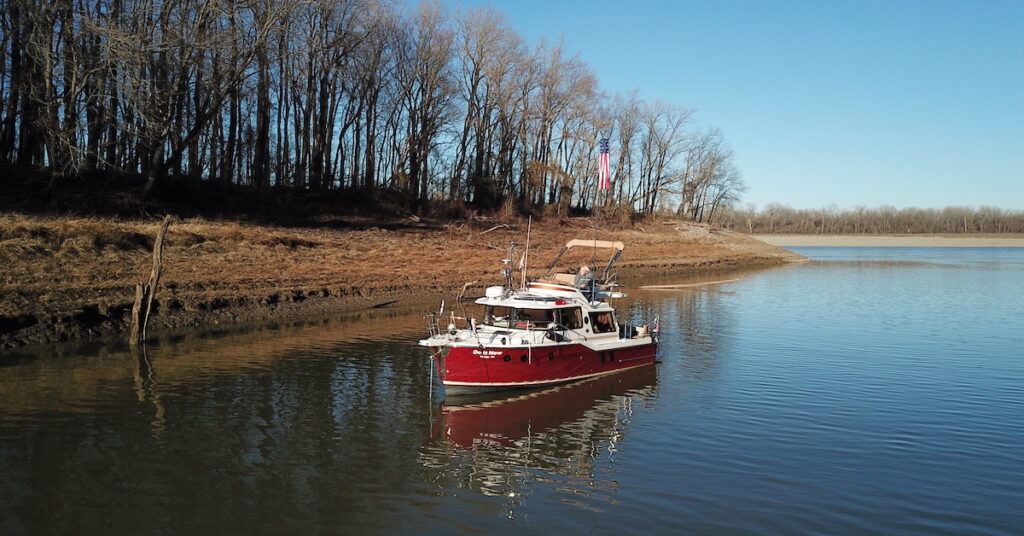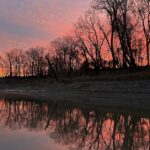November 30, 2022: A long day on the river, ending with my second anchorage on the trip.
(continued from Kimmswick, MO (Hoppie’s) to Modoc, IL (Kaskaskia Lock Wall))
When we woke up, it was literally freezing outside. Below 32°F. There was frost on everything outside, including the midship line I’d used to fasten the boat to the bottom of the rail. I had trouble untying it because it was pretty much frozen.
After a quick walk on the wall with my pups — I can’t remember if I put their new coats on them or not — we all came back into the boat to have breakfast. It was toasty inside — the boat’s excellent diesel heater does a great job of warming up the inside of the boat, especially the front cabin. We made coffee and hot cereal and soon had the windows steamed up with condensation.
Heading Out
It took two tries to start the engine. I figured it was because it was so cold outside and didn’t give it another thought. I let the engine warm up to more than 125° before telling Alyse to cast off. I’d already removed most of the lines. There wasn’t much wind so the boat wasn’t trying to get away. I pulled away from the wall, turned down the Kaskaskia River, and motored away slowly while Alyse pulled in the fenders. When she was back inside, I added power and steered us out toward the Mississippi River.
AIS showed me that there was a tow coming up the river and I called him to establish what side I’d pass him on. We passed as planned and he came back on the radio with a bunch of questions about my boat and the trip we were doing. He seemed impressed. My type of boat — a Ranger Tug — is not very common in the east, although it’s crazy popular in the Pacific Northwest where they’re built. I get a lot of questions about it and it’s a pleasure to answer them and help educate folks.
Back on the Mississippi
Back on the Mississippi River, the current helped us along our way. I was in full fuel saving mode at this point. My goal was to keep the fuel economy to at least 2 nautical miles per gallon until I was certain I’d have enough fuel to get us to the next fuel stop in Paducah. My notes for the day indicate I cruised at 2000 RPM, 1820 RPM, and 2200 RPM, with speeds of 10 kts, 9.5 kts, and 10.3 kts respectively. Mileage was 2.6 nmpg, 3.2 nmpg, and 2 nmpg. All pretty darn good numbers. But I’d been warned that things would changed when I turned up the Ohio River, so I wasn’t taking chances. With 145 gallons on board to start, I should be able to do 290 miles if I kept it to 2 nmpg or better. I only needed to do 204 miles total, so things were looking good — and we were making good time, to boot.
We stayed warm in the cabin with the helm heat blowing in on us. There was nothing terribly interesting along the way. My notes say I followed a specific tow — Inez Andreas — “through the chute” before passing at 15 knots. Maybe it was a big deal then, but we passed so many tows in the six weeks I was on the river system that I don’t remember all of them. I’m not sure why I bothered to make notes about this one.
Our Anchorage

The Aqua Map chart shows the anchorage past a very shallow area on the channel off the Mississippi. I had my doubts, but we had no trouble getting in.
We passed a bunch of suitable anchorages along the way, but I was holding out for a specific one just south of Cape Girardeau, MO. The ones along the river were tucked into the bank behind special walls designed to minimize erosion. They were tricky to get and out of and I didn’t want too much of a challenge on my second anchorage and Alyse’s first. The one I wanted, which was called Little River Diversion Channel, was right inside the mouth of a canal that joined the Mississippi just south of town. Kenny and Rhonda in Nine Lives had recommended it and Kenny and Rhonda know good anchorages. I was a little concerned about the depth of the water at the entrance, mostly because Aqua Map showed it to be very shallow, but I knew that if Nine Lives had gone in, we could, too.
We reached it at about 2 PM, after traveling about 60 nautical miles. I drove past the entrance slowly, thinking that it looked pretty narrow. There was a fallen tree on one side, but there did seem to be plenty of room to get Do It Now in. So I came back up the river against the current, aimed for the opening, and slipped in, immediately reducing power to idle forward once we were out of the Mississippi’s strong current.
There were no other boats in there, which was honestly no surprise at that point. I was convinced that we were the last loopers coming down the Mississippi so I would have been surprised to find a boat in there. Kenny and Rhonda had shared the space with two other boats earlier that month. They’d instructed me to drive in a bit because the water got a little deeper farther in. I was showing about 12-15 feet in the middle of a channel that was probably 150 feet wide, with shallow banks and some small fallen trees on both sides.
I waited, nearly motionless in the channel, while Alyse, on the bow, figured out the windlass’s two foot controlled buttons and dropped the anchor. We wound up drifting toward the north side of the channel, but we weren’t close enough for it to be an issue. We weren’t as organized as we should have been, so I think a lot of the chain just piled up on the bottom before I could run the motor backwards to set the anchor. In the end, we probably put out about 75 feet of chain and rode. The boat held fast, pointed up the channel. When I was sure it wasn’t going to move, I killed the engine.
We’d arrived at our overnight destination.

Here’s the Nebo log for November 30, 2022. Download a PDF log file with more info. Track Do It Now on Nebo.
At Little River Diversion Channel
It was still early in the day so I managed to do two things outside while we were there.
The first was launching the dinghy to take my pups to shore. This required me to release the dinghy from the two poles that hold up behind my boat and let it drop to the water. The dinghy is connected to my boat with weaver davits, which form hinges that hold the boat in place. While it was still attached, I unwrapped my oars and the single seat, which had never been used, and installed them in the boat. Then I put my pups in the boat, released the boat from the weaver davits, and stepped inside, holding onto the swim platform’s rail to keep steady. I rowed us to shore.
From Do It Now, I couldn’t tell if the shore was rocky or muddy. It was muddy. Very muddy. A soft, slick mud that was difficult to walk on and got all over the bottom of my shoes. I tied the boat to a tree and made my way out to firmer ground with my pups. They ran around a little but were definitely nervous about their surroundings. They did their business and we got back into the boat, trailing all that mud with us. I also managed to get mud on my jacket, probably from picking up the girls and putting them back into the boat.

Alyse shot this photo of our second trip to shore in the dinghy. I had no desire to get back into that mud and waited for the girls to finish while holding onto a branch.
I rowed back. It was a very short trip. I tied the boat to one of the dinghy cleats on the swim platform and got us all back onto the boat. I spent a few minutes cleaning the dogs’ feet before letting them back in. I left my mud-caked shoes outside on the aft deck.
That hadn’t been so bad, I decided. Of course, there was virtually no current or wind and it had been a short trip.
The other thing I did was launch my drone. I wanted a photo of my boat in this very cool anchorage. I launched it off the solar panel, which was pretty much the only flat, mostly level surface on the boat that didn’t have a cover over it.

Here is one of the drone shots I took of the boat after anchoring at Little River Diversion Channel. Behind us is the Mississippi River. I really liked this anchorage a lot; it was the kind of mellow place I could spend a few days at, just to relax and read or write.
While we did our things, an occasional tow would come past on the river. We were far enough back in the channel that any wake they generated barely reached us. When it got dark, their spotlights would sometimes shine up the channel at us. Some of the boats were lit up with holiday lights.
We made and ate dinner and settled in for the night. Although I set an anchor alarm, I don’t think we moved more than a few feet all night. It was wonderfully quiet, protected, and secure.



Sounds like a good day, back in November.
Chilly, but good!
It was a good day. We covered a lot of ground and ended up in one of my favorite anchorages so far.